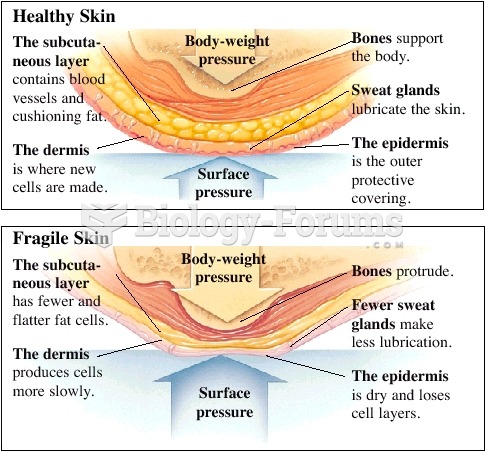Answer to Question 1
1 . Basal cell carcinoma. Basal cells form the base, or the innermost layer of the epidermis.
2 . Squamous cell carcinoma. Squamous originates from the word scale.. These flatter cells form the outside layer of the epidermis and shed as new cells form.
3 . Malignant melanoma. Melanoma originates in cells that create melanin, which gives color to skin.
Sun lamps and tanning parlors provide mainly ultraviolet A (UVA) rays. Once thought to be safe, they, too, are now known to be damaging and have been linked to melanoma. Sunscreen lotion should be applied about 30 minutes before lengthy exposure to the sun because the skin takes that long to absorb the protective ingredients. Select sunscreens labeled broad-spectrum, as these products block both UVA and UVB rays. A sun protection factor (SPF) of at least 15 is recommended. During peak hours, reapplication is vital. For face protection on an average day, it is probably most realistic for the majority of people to apply sunscreen in the morning and then wear a protective hat when outdoors the remainder of the day. When swimming or sweating especially, you should reapply waterproof sunscreens more often because all sunscreens lose strength when they are diluted. If you plan on being out in the sun for a lengthy period of time, even better than sunscreen is wearing protective clothing, including long-sleeved shirts, long pants, and a hat with a two- to three-inch brim all the way around.
Answer to Question 2
The common cold, the flu, herpes, hepatitis, and AIDS are viral diseases.
The most common viruses are:
Rhinoviruses and adenoviruses, which get into the mucous membranes and cause upper respiratory tract infections and colds.
Coronaviruses, named for their corona, or halo-like appearance, are second only to rhinoviruses in causing the common cold and other respiratory infections. A coronavirus is the cause of severe acute respiratory syndrome (SARS).
Influenza viruses, which can change their outer protein coats so dramatically that individuals resistant to one strain cannot fight off a new one.
Herpes viruses, which take up permanent residence in the cells and periodically flare up.
Papillomaviruses, which cause few symptoms in women and almost none in men but may be responsible, at least in part, for a rise in the incidence of cervical cancer among younger women.
Hepatitis viruses, which cause several forms of liver infection, ranging from mild to life-threatening.
Slow viruses, which give no early indication of their presence but can produce fatal illnesses within a few years.
Retroviruses, which are named for their backward (retro) sequence of genetic replication compared to other viruses. One retrovirus, human immunodeficiency virus (HIV), causes acquired immune deficiency syndrome (AIDS).
Filoviruses, which resemble threads and are extremely lethal.







